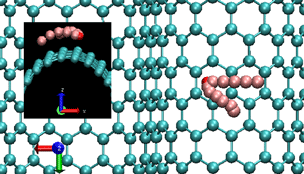Crossref Citations
This article has been cited by the following publications. This list is generated based on data provided by
Crossref.
Chen, Yingqian
and
Manzhos, Sergei
2014.
Li Storage on TCNE and TCNE-(Doped)-Graphene Complexes: a Computational Study.
MRS Proceedings,
Vol. 1679,
Issue. ,
Cai, Qiran
Li, Lu Hua
Yu, Yuanlie
Liu, Yun
Huang, Shaoming
Chen, Ying
Watanabe, Kenji
and
Taniguchi, Takashi
2015.
Boron nitride nanosheets as improved and reusable substrates for gold nanoparticles enabled surface enhanced Raman spectroscopy.
Physical Chemistry Chemical Physics,
Vol. 17,
Issue. 12,
p.
7761.
Malyi, Oleksandr I.
Sopiha, Kostiantyn
Kulish, Vadym V.
Tan, Teck L.
Manzhos, Sergei
and
Persson, Clas
2015.
A computational study of Na behavior on graphene.
Applied Surface Science,
Vol. 333,
Issue. ,
p.
235.
Chen, Yingqian
and
Manzhos, Sergei
2015.
Lithium and sodium storage on tetracyanoethylene (TCNE) and TCNE-(doped)-graphene complexes: A computational study.
Materials Chemistry and Physics,
Vol. 156,
Issue. ,
p.
180.
Medasani, Bharat K.
Liu, Jun
and
Sushko, Maria L.
2017.
Stable Pt clusters anchored to monovacancies on graphene sheets.
MRS Communications,
Vol. 7,
Issue. 4,
p.
891.
Kulish, Vadym
Koch, Daniel
and
Manzhos, Sergei
2017.
Insertion of Mono- vs. Bi- vs. Trivalent Atoms in Prospective Active Electrode Materials for Electrochemical Batteries: An ab Initio Perspective.
Energies,
Vol. 10,
Issue. 12,
p.
2061.
Bommier, Clement
Mitlin, David
and
Ji, Xiulei
2018.
Internal structure – Na storage mechanisms – Electrochemical performance relations in carbons.
Progress in Materials Science,
Vol. 97,
Issue. ,
p.
170.
Bommier, Clement
Ji, Xiulei
and
Greaney, P. Alex
2019.
Electrochemical Properties and Theoretical Capacity for Sodium Storage in Hard Carbon: Insights from First Principles Calculations.
Chemistry of Materials,
Vol. 31,
Issue. 3,
p.
658.
Yang, Junwei
Yuan, Yanhong
and
Chen, Guohong
2020.
First–principles study of potassium adsorption and diffusion on graphene.
Molecular Physics,
Vol. 118,
Issue. 1,
p.
e1581291.
Yamaletdinov, Ruslan D.
and
Pershin, Yuriy V.
2020.
Ultrafast lithium diffusion in bilayer buckled graphene: A comparative study of Li and Na.
Scripta Materialia,
Vol. 178,
Issue. ,
p.
139.
Kizzire, Dayton G.
Richter, Alexander M.
Harper, David P.
and
Keffer, David J.
2021.
Lithium and Sodium Ion Binding Mechanisms and Diffusion Rates in Lignin-Based Hard Carbon Models.
ACS Omega,
Vol. 6,
Issue. 30,
p.
19883.
Weiss, Manuel
Ruess, Raffael
Kasnatscheew, Johannes
Levartovsky, Yehonatan
Levy, Natasha Ronith
Minnmann, Philip
Stolz, Lukas
Waldmann, Thomas
Wohlfahrt‐Mehrens, Margret
Aurbach, Doron
Winter, Martin
Ein‐Eli, Yair
and
Janek, Jürgen
2021.
Fast Charging of Lithium‐Ion Batteries: A Review of Materials Aspects.
Advanced Energy Materials,
Vol. 11,
Issue. 33,
Zhang, Menghang
Pan, Hui
Wang, Yigang
Yang, Jingui
Dong, Hao
He, Ping
and
Zhou, Haoshen
2023.
Research on Li+/Na+ Selectivity of NASICON-Type Solid-State Ion Conductors by First-Principles Calculations.
Energy & Fuels,
Vol. 37,
Issue. 14,
p.
10663.
Pacheco-Sanjuán, Alejandro
and
Batra, Romesh C.
2023.
Insights into the auxetic behavior of graphene: A study on the temperature dependence of Poisson's ratio and in-plane moduli.
Carbon,
Vol. 215,
Issue. ,
p.
118416.
Hendra
and
Witek, Henryk A.
2024.
Energy Decomposition Scheme for Rectangular Graphene Flakes.
Nanomaterials,
Vol. 14,
Issue. 2,
p.
181.
